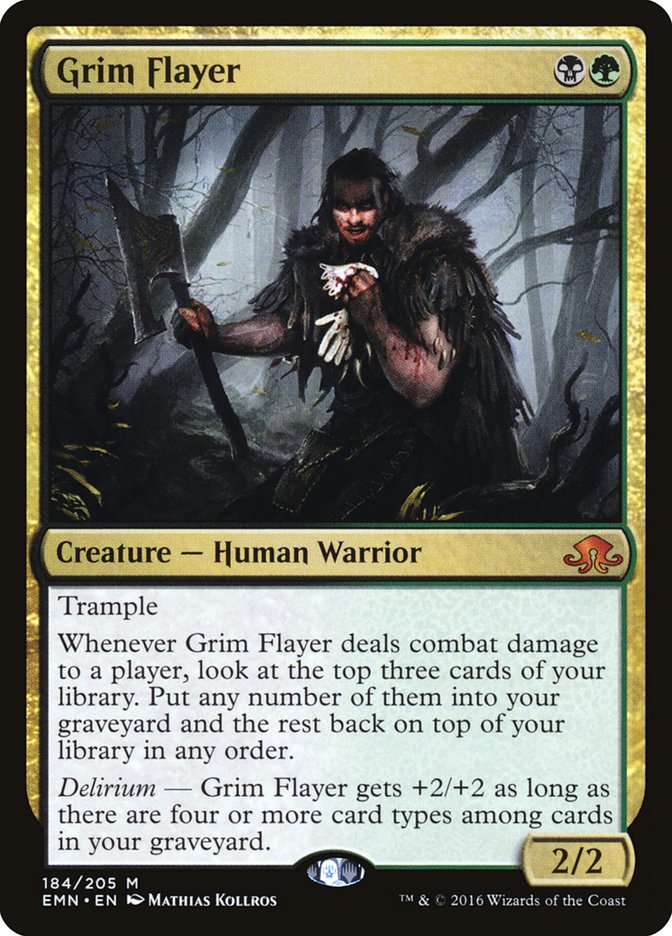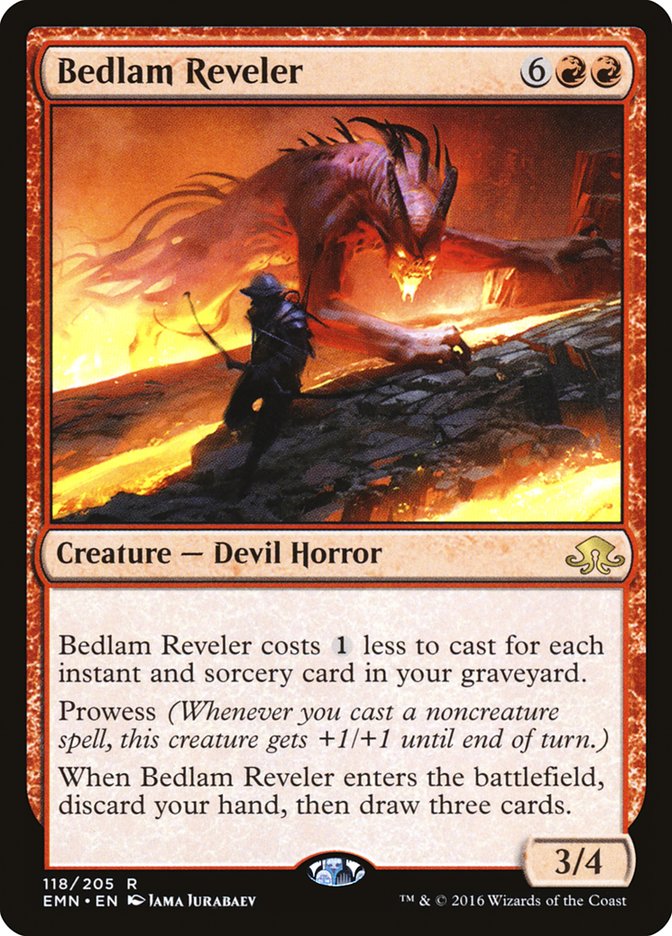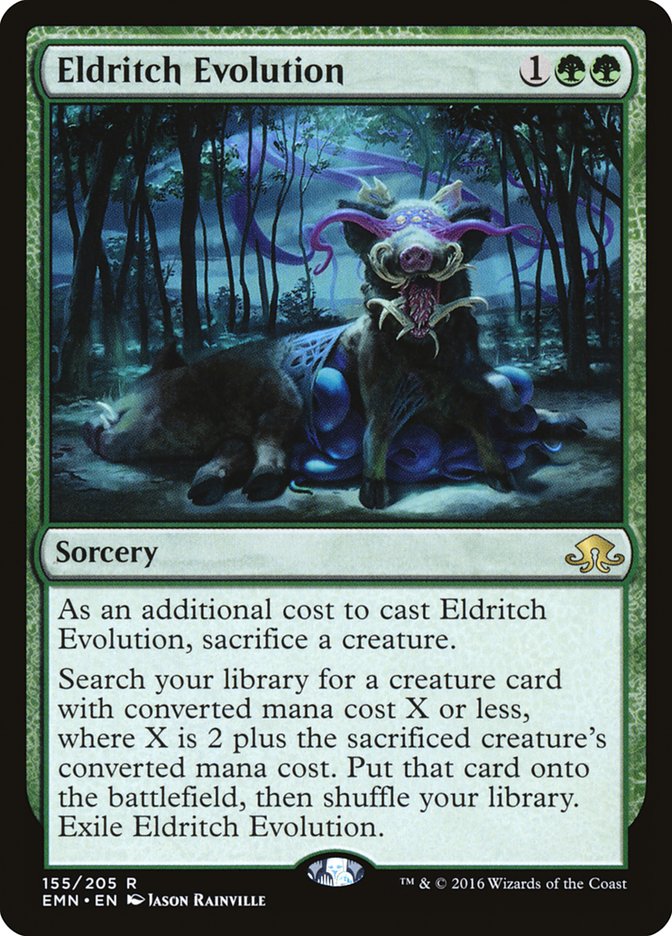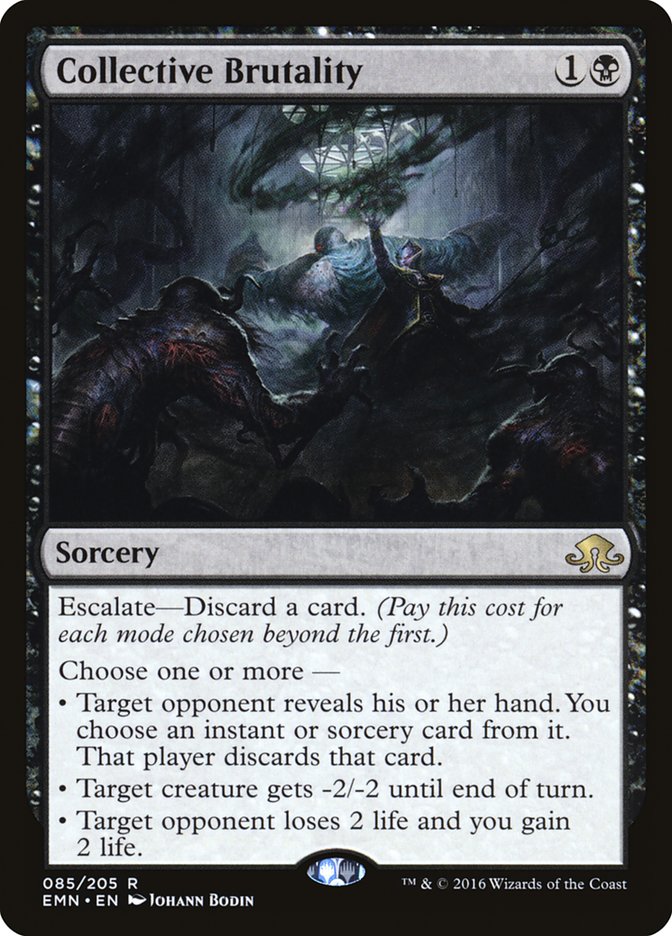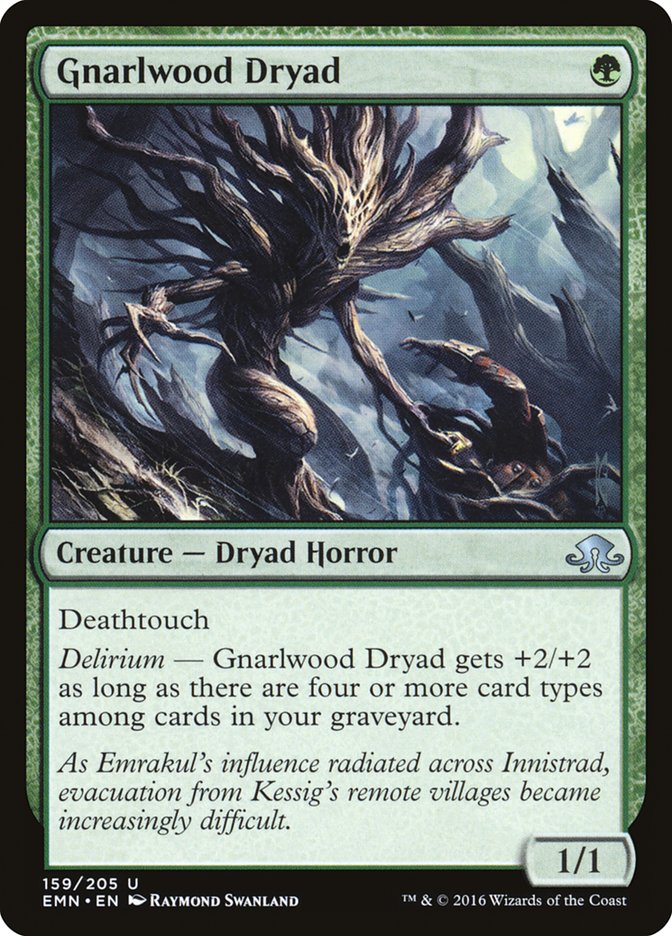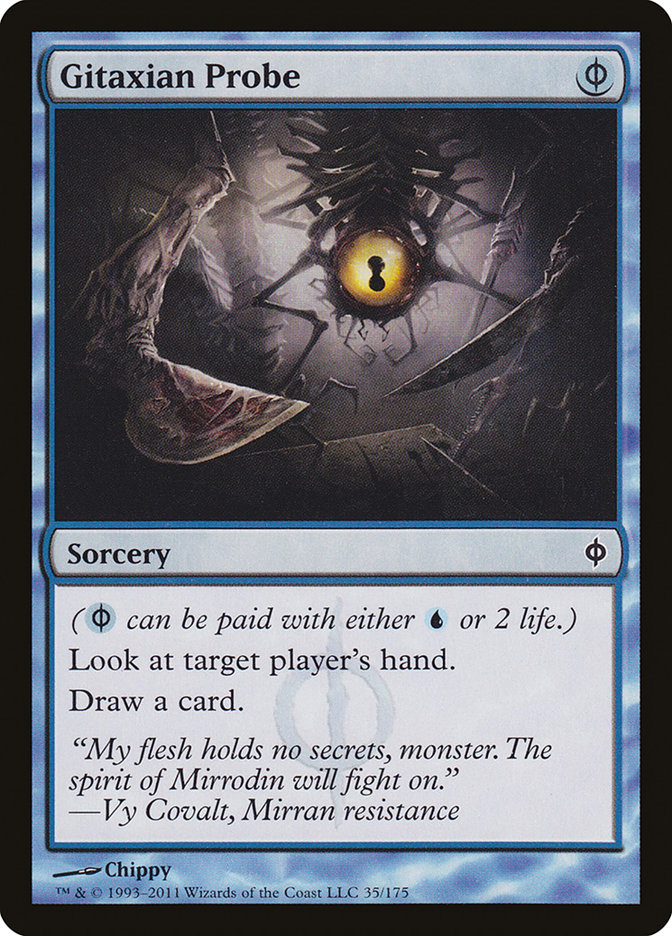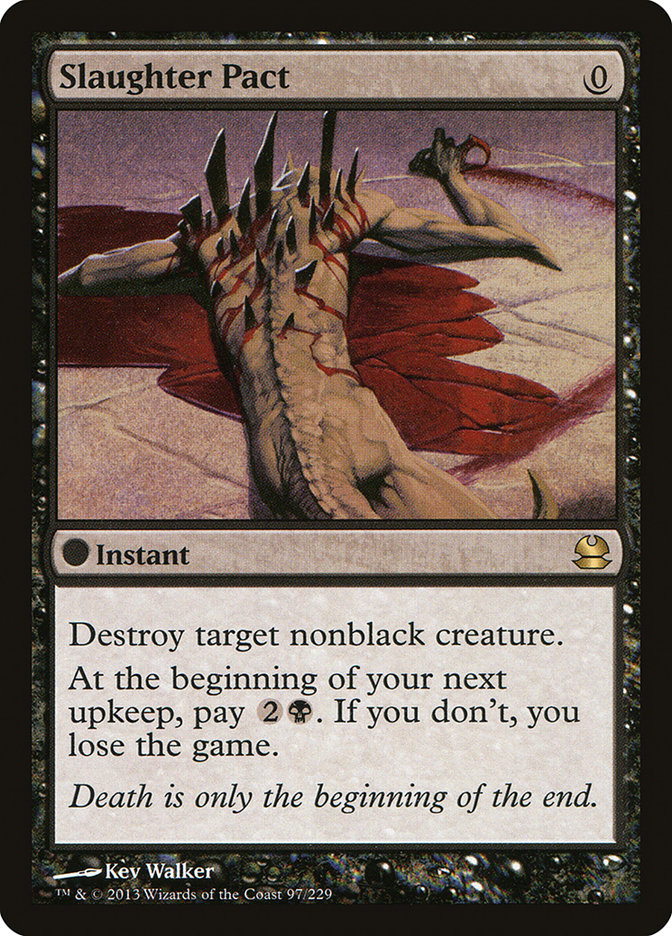It’s official. Modern got some new toys from Eldritch Moon.
Bedlam Reveler is the card I’ve been most excited about, but why?
Grixis is where my heart is. It aims to trade resources and eventually win with Snapcaster Mage beatdown or overwhelming advantage from Jace, Vryn’s Prodigy; Ancestral Vision; or Kolaghan’s Command. There is never a set plan, and what you draw dictates which game plan you run with.
There are inherent issues with Jace and Ancestral Vision, considering how fast Modern is (and especially with how difficult the decks are to interact with at times), so having something that is both card advantage and a beater is immensely helpful. If you need any further proof, look at Snapcaster Mage. Grixis is typically pretty good at getting hellbent or close to it, especially if you’re not playing Ancestral Vision, so Bedlam Reveler seems like a natural fit.
Why Grixis? Isn’t Modern All Bad Matchups?
Sort of. Tron, Burn, and various Collected Company decks aren’t things I would necessarily put into the “good” matchup category. However, if you look at Chapin’s table, the only decks I would consider bad matchups near the top are Valakut and Dredge. Everything else is beatable without having to try too hard. There’s also a lot of overlap between cards that are good against the top archetypes. There are big creature decks and small creature decks, but those are just creature decks. Grixis can kill them all.
Anger of the Gods and Kalitas, Traitor of Ghet seemed to have pushed out all the Voice of Resurgences and Kitchen Finks from the format, so Lightning Bolt is phenomenal right now. You still need some Terminate effects for Death’s Shadows and the like.
Lightning Bolt is great and Grixis is (arguably) the best Lightning Bolt deck. At the very least, Grixis gets the most mileage from Lightning Bolt.
So, Just Add Some Bedlam Revelers to Stock Grixis?
No. Building with Bedlam Reveler is difficult!
It’s part Treasure Cruise, part Monastery Swiftspear, but you also don’t want to cast it until you’ve basically spent your hand. The tricky part is figuring out a way to get your cards to line up when your opponents aren’t doing you any favors.
Depending on the matchup, you’re going to have Terminate, Mana Leak, or Inquisition of Kozilek that won’t trade well. When that happens, you should be fine with casting Bedlam Reveler and ditching a couple of dead ones. There could be issues where your Bedlam Reveler isn’t cheap and you don’t even have that option.
Of these, Mana Leak was the biggest offender. I’ve been building my Modern decks to hedge against decks like Tron, Scapeshift, and Ad Nauseam for a while, but now I think it’s time to stop. Those decks are a small portion of the metagame, and it’s not like my record has ever been great against them anyway. Instead, I should focus on beating the small creature decks and other midrange decks. That is definitely doable!
Of course, if I can hedge some of those matchups, I’ll try, but it isn’t worth the effort.
After I busted out of the Invitational, I played the Modern Open. Because of my disappointing finish with Abzan (but mostly because of how bad it felt), I wasn’t eager to run it back. It was time to try another idea for Bedlam Reveler Grixis that I was kicking around.
After being very impressed with Bedlam Reveler, I went ahead and maxed out the amount of copies I could play. Because of that, I was looking to turbo-charge them and see how far I could take that aspect of the archetype. When you’re trying to figure out if something works or not, it’s often best to test the ends of the spectrum, even if you think meeting somewhere in the middle is correct. You learn more at a faster rate, and I learned plenty.
Gitaxian Probe actually played poorly with Bedlam Reveler, and my entire deck in general!
With so many cantrips, I didn’t want to play a bunch of lands only to flood out. Since I had Gitaxian Probes, I went down to 21 lands. That further exacerbated my problem of not being able to empty my hand, while also making sure that it was always full of spells. This deckbuilding error was to blame in most of my losses, where I was stuck on two to four land but unable to capitalize on Bedlam Reveler.
The tension between wanting to make all your land drops and have cantrips and other spells to make Bedlam Reveler cost less, while also wanting to bait out removal to get your Bedlam Reveler to stick, is very real.
Like I said, it’s difficult to build around.
Going forward, I know that I want plenty of lands, since I should be able to make Bedlam Reveler cost two mana regardless of what’s happening in the game, and I want access to plenty of mana in order to utilize the cards I draw. We still have the problem of converting your semi-dead resources into something useful, though. Collective Brutality is the best way to do that. Liliana of the Veil might be another option.
Against Burn, a notoriously bad matchup, you get to kill their creature, gain two life, and make them discard a burn spell, all for two mana. It costs you cards, but there are so many dead cards in the matchup that it doesn’t typically matter. You need to keep your head above water and race them, so Collective Brutality is the best way to do it.
Against any deck with Chord of Calling or Collected Company, Collective Brutality is excellent as well.
Shout-out to Craig Cliburn for the heads-up on Collective Brutality!
While Collective Brutality is nice, it doesn’t fix every problem. This card might.
In a control deck, Faithless Looting isn’t what we want. However, it is what we want in our Bedlam Reveler deck, which probably means we don’t want to be a hard control deck. At the very least, maybe it means we shouldn’t be building them in the same way. Given my admission of playing too many reactive cards for spells, and the fact that Modern requires more interaction for dealing with permanents, Faithless Looting might be exactly what we want.
If you wanted to try pure control without Faithless Looting, I wouldn’t fault you. Bedlam Reveler is still good there.
Creatures (8)
Planeswalkers (2)
Lands (21)
Spells (29)

I’ll be trying some Faithless Lootings in this version as well (alongside a fourth Bedlam Reveler), probably at the expense of a Mana Leak; a Liliana, the Last Hope; and a Thoughtseize. Once you can configure your deck how you want it post-sideboard, I would expect the Faithless Lootings to be less good in most matchups though. I could understand wanting to play without them, and this list is posted just for you, but I do think they will make the archetype better as a whole.
One of the downsides to Grixis is that you can’t effectively beat Dredge. However, that deck doesn’t seem to be one of the decks people are willing to just pick up in Modern. Maybe they assume it’s a flash in the pan or that everyone else is going to beat it for them. Maybe it’s weird and it’s “not Magic,” so they don’t want to play it.
Either way, the deck isn’t going to be popular in most tournaments. I would respect it, but I wouldn’t shift my deck selection based on it. While graveyard hate is good against Bedlam Reveler, it doesn’t really matter unless it’s Rest in Peace or Leyline of the Void, both of which aren’t very popular because of how narrow they are.
The mana is tight, as you often need RR, BB, and UU early, so the Scars lands are a welcome addition. I could even see a second Darkslick Shores instead of a fetchland. The second Bloodstained Mire is more important than Polluted Delta because you fetch Island and Mountain way more than you fetch Swamp. You could go without Liliana, the Last Hope to ease up on the mana requirements, but I think it’s doable to keep her and still function.
Rise // Fall is another card that I’ve considered, and it might be awesome. The whole idea is to re-use Bedlam Reveler as much as possible. You typically get that chain started by milling one with Thought Scour and picking it up with Kolaghan’s Command or Liliana, the Last Hope, so Rise // Fall could be a nice addition to that engine.
Four removal spells for big creatures has felt like enough. When I had three maindeck, I often felt light and wanted to sideboard into a fourth. Right now, I think maindecking four is correct. Post-sideboard, you’ll typically have additional help.
Shriekmaw should be excellent with Kolaghan’s Command and Liliana, the Last Hope, but again, it’s all about balance. It doesn’t work well with Bedlam Reveler, but we can afford to sacrifice some synergy there. The one thing I’m worried about with Shriekmaw and Slaughter Pact is how many black creatures there are right now. Grim Flayer, Dark Confidant, and Death’s Shadow are prevalent, so I’ll likely have to cut one of those effects.
Of the two, Slaughter Pact probably has the most upside. You can cast it to make Bedlam Reveler cheaper, cast the Reveler, and still probably have mana left over to do other stuff. When you have Snapcaster Mage, you can flash it back for zero, which is powerful, even if they can see it coming. The upside against Arcbound Ravager and Become Immense is enormous.
Shriekmaw’s upside is not dealing you damage against Eidolon of the Great Revel, being recurrable, and potentially being a threat. While sorcery speed isn’t ideal, it is one of the best cards against Bant Eldrazi.
We have an embarrassment of riches when it comes to dealing with small creatures.
You have to get the mix just right, while also not overdoing it. At that point, you run the serious risk of getting beaten up by Tarmogoyfs. I’d be more than happy maindecking a second Collective Brutality, but I didn’t want to play a bunch of cards that only hit two- and three-toughness creatures. The Burn matchup probably deserves whatever help I can give it.
The sideboard is interesting. I’m certainly lacking in some departments. I don’t have much to help against Tron and Valakut. The Surgical Extractions are more for Dredge, but I will likely end up Thought Scouring my Tron opponents, hoping to spike a Tron land. Instead of more hate for those decks, I actually need a threat. Bedlam Reveler might be good enough if deployed early, but that requires further testing. I’m probably just in trouble, so sideboarding a couple extra cards wouldn’t help very much.
Anger of the Gods is absent, but so are the decks that Anger is good against. In their place, I have Engineered Explosives, which is more of a nod to Affinity and Death’s Shadow. Dredge is going to be tough, even with the Surgical Extractions, which probably means I need to reconfigure the whole sideboard.
What about playing Bedlam Reveler in a deck that’s threat-dense? If you want to play a more aggressive version, this is my initial list.
Creatures (13)
Lands (17)
Spells (30)
- 4 Lightning Bolt
- 1 Mountain
- 2 Island
- 4 Serum Visions
- 2 Spell Pierce
- 3 Forked Bolt
- 4 Gitaxian Probe
- 4 Vapor Snag
- 2 Faithless Looting
- 4 Thought Scour
Sideboard

There are plenty of things to like about this list. First of all, it has Monastery Swiftspear to draw opposing Lightning Bolts and other removal, potentially clearing the way for Bedlam Reveler. Second, it has access to Vapor Snag to rebuy Bedlam Reveler. Finally, we get to do things like maindeck Forked Bolt and a pile of U/R two-color lands with Shattering Spree in the sideboard.
The trickiest thing is now balancing the amount of threats we want alongside Bedlam Reveler. Young Pyromancer, Stormchaser Mage, Delver of Secrets, and Thing in the Ice are all considerations. Of these, Thing in the Ice seems like the most powerful. Did you know that Bedlam Reveler is also a Horror? I’m honestly not sure if that’s a bonus or a drawback in this deck.
So why jump through all these hoops to make Bedlam Reveler work? In short, because it’s very good. The upside of “big threat plus draw three cards” is huge and is exactly the type of finisher Grixis wants. As of this writing, I don’t think I’m going to Grand Prix Indianapolis. If you gave me another week to practice, then it might be another story. For now, I’m not 100% confident in my decklists, but I know I’m getting close.


